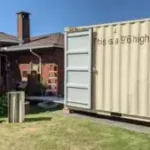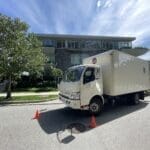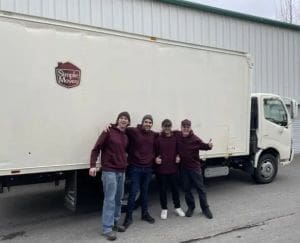Estimated reading time: 4 minutes
Table of contents
Moving and storage are two sides of the same coin. Chances are, if you’re moving, you have to put some of your stuff in storage. And unless you’re paying the moving company extra to use their storage building, you must rent a self-storage unit.
You know, those boxy, mini-warehouse buildings that line the sides of highways from Vancouver to Toronto? Renting storage units seems like a pretty open-and-shut job: you open the door to your self-storage unit, shove your stuff in, and shut the door. But public storage isn’t that pretty simple. Even though it’s just sitting there, a lot could happen to your stuff in self-storage. You must pick the right self-storage facility; once you do, it’s even more essential to pack your storage unit correctly.
Before you lease anything, check out the following tips:
When Selecting a Self-Storage Facility
- Think about location. Will you need to access your storage building frequently? If so, aim for somewhere nearby.
- Consider how much space you need. Self-storage facilities rent units in all different sizes. It’s best to opt for a smaller storage unit and pack it to the ceiling rather than pay for space you’re not using. If even the smallest storage units are too much, look into mini-storage facilities, which specialize in small loads.
- Ask facility representatives how and when you can access your unit. Most self-storage and mini-storage facilities offer free access 24 hours a day, but some have restrictions, and others charge fees.
- Also, ask about climate-controlled units. If you’re storing anything valuable or delicate—like antique furniture or important documents—it could be warped by being stored in a space that’s too hot, too cold, or too humid. For an extra cost, most public storage facilities can set you up with a unit where temperature and humidity are restricted.
When Packing Up Your Self-Storage Unit
- Try to use boxes that are uniform in size; they’re easier to stack (remember: keep the heavy ones on the bottom and the light ones on top).
- Leave small walkways between the boxes and furniture in your storage unit so you can quickly access the items you want without moving anything around.
- If you’re storing many packing boxes in your unit, try to fill them to the top, even if it’s just with padding and old, crumpled newspapers. Boxes that are only half-filled tend to collapse if anything is placed on them.
- If you’re storing metal objects—like lawnmowers or file cabinets—it’s best to treat them with a rust protector first or at least wipe them down with an oily rag.
- Most public storage facilities have ample security. However, it’s still wise to take a few precautions against theft. Pack your storage unit so that your most valuable items are at the back, and purchase a high-quality padlock to put on the door.
- The humidity in your self-storage unit can cause your furniture to warp and your appliances to mildew. Leaving a space between your stuff and the unit’s wall allows air to circulate within the unit. Laying plastic sheeting on the floor and stacking boxes on top of wooden pallets can prevent condensation damage. Using old linens or other fabrics instead of plastic to protect your stuff from dust can also help.
- Leave the door ajar if you’re storing a refrigerator in your unit. This will prevent mould from growing inside.
- Under no circumstances should you keep anything flammable or combustible in your storage building. This means no gasoline, oil, cleaning fluids or paint thinner. If you’re storing any machinery that runs on gas, drain the tank before you store it.
If this sounds like something you’d want to avoid, give us a call instead, and we will store your items for you without worry.
Frequently Asked Questions
- What should I consider when choosing a self-storage facility?
Location is key; choose a facility nearby if you need frequent access. Assess your space requirements and ask about access hours and climate-controlled options. - How should I pack my self-storage unit effectively?
Use uniform-sized boxes, leave walkways for access, and fill boxes to prevent collapse. Protect metal items from rust and position valuables at the back for security. - Are there items that shouldn’t be stored in a self-storage unit?
Avoid storing anything flammable or combustible, like gasoline or paint thinner. Ensure that the gas tanks in the machinery are emptied before storage.
Read More
Will Movers Move Things Not in Boxes?
Ways to Properly Prepare Your Items for Storage
What Are The Best Tips For Home Improvement Projects And How To Save Money?




